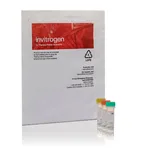
Thermo Fisher Scientific CD183 (CXCR3) Monoclonal Antibody (CEW33D), NovaFluor Red 710, eBioscience
✨AI 추천 연관 상품
AI가 분석한 이 상품과 연관된 추천 상품들을 확인해보세요
연관 상품을 찾고 있습니다...
Applications
Tested Dilution
Publications
Flow Cytometry (Flow)
5 µL (0.8 µg)/test
Product Specifications
Species Reactivity
Human
Host/Isotype
Mouse / IgG1, kappa
Class
Monoclonal
Type
Antibody
Clone
CEW33D
Conjugate
NovaFluor™ Red 710 NovaFluor™ Red 710 NovaFluor™ Red 710
View additional formats
- APC
- Biotin
- Brilliant UV 615
- eFluor 660
- NovaFluor Blue 660-120S
- NovaFluor Red 685
- NovaFluor Red 725
- NovaFluor Yellow 690
- PE
- PE-Cyanine7
- PE-eFluor 610
- Request custom conjugation
Excitation/Emission Max
637/713 nm View spectra 
Form
Liquid
Concentration
0.8 µg/Test
Purification
Affinity chromatography
Storage buffer
PBS, pH 7.2, with BSA
Contains
0.09% sodium azide
Storage conditions
4° C, store in dark, DO NOT FREEZE!
Product Specific Information
Description: The CEW33D monoclonal antibody reacts with human CD183. CD183, also known as CXCR3, is a G protein-coupled chemokine receptor that interacts with ligands CXCL9 (MIG), CXCL10 (IP-10), and CXCL11 (I-TAC). Strongly associated with type 1 immunity, CD183 is induced in naive T cells upon activation and remains upregulated in T helper type (Th)1 cells, CD8 effector cells, NK cells and NKT cells. CD183-ligand interactions mediate infiltration of inflamed tissues in normal type 1 immune responses as well as in many inflammatory and autoimmune diseases. CD183 is also expressed on some B cells and plasmacytoid DC.
Applications Reported: This CEW33D antibody has been reported for use in flow cytometric analysis.
Applications Tested: This CEW33D antibody has been pre-titrated and tested by flow cytometric analysis of normal human peripheral blood cells. This can be used at 5 µL (0.8 µg) per test. A test is defined as the amount (µg) of antibody that will stain a cell sample in a final volume of 100 µL. Cell number should be determined empirically but can range from 10^5 to 10^8 cells/test.
Each product contains 1 vial of NovaFluor conjugate and 1 vial of CellBlox Plus Blocking Buffer .
NovaFluor dyes are not compatible with DNA intercalating viability dyes. Do not use viability dyes such as propidium iodide, 7-actinomycin D (7-AAD) and DAPI. Invitrogen LIVE/DEAD Fixable Dead Cell stains are recommended for use with NovaFluor dyes.
This NovaFluor conjugate has been updated to ship with CellBlox Plus Blocking Buffer (Cat. No. (C001T06F01)). This buffer contains formulation improvements over CellBlox. CellBlox Plus Blocking Buffer is required for optimal staining with NovaFluor conjugates and should be used in all experiments where NovaFluor conjugates are used. Whenever possible, we recommend adding CellBlox Plus Blocking Buffer to antibody cocktails/master mixes prior to combining with cells. Add 5 µL per sample (regardless of the number of NovaFluors in your panel) to use the antibody cocktail as intended. For single-color controls, use 5 µL of CellBlox Blocking Buffer per 100 µL of cell sample containing 10^3 to 10^8 cells.
NovaFluor conjugates are based on Phiton™ technology utilizing novel nucleic acid dye structures that allow for engineered fluorescent signatures with consideration for spillover and spread impacts. Learn more
Excitation: 639 nm; Emission: 710 nm; Laser: 633-640 nm (Red) Laser
Target Information
This gene encodes a G protein-coupled receptor with selectivity for three chemokines, termed IP10 (interferon-g-inducible 10 kDa protein), Mig (monokine induced by interferon-g) and I-TAC (interferon-inducible T cell a-chemoattractant). IP10, Mig and I-TAC belong to the structural subfamily of CXC chemokines, in which a single amino acid residue separates the first two of four highly conserved Cys residues. Binding of chemokines to this protein induces cellular responses that are involved in leukocyte traffic, most notably integrin activation, cytoskeletal changes and chemotactic migration. Inhibition by Bordetella pertussis toxin suggests that heterotrimeric G protein of the Gi-subclass couple to this protein. Signal transduction has not been further analyzed but may include the same enzymes that were identified in the signaling cascade induced by other chemokine receptors. As a consequence of chemokine-induced cellular desensitization (phosphorylation-dependent receptor internalization), cellular responses are typically rapid and short in duration. Cellular responsiveness is restored after dephosphorylation of intracellular receptors and subsequent recycling to the cell surface. This gene is prominently expressed in in vitro cultured effector/memory T cells, and in T cells present in many types of inflamed tissues. In addition, IP10, Mig and I-TAC are commonly produced by local cells in inflammatory lesion, suggesting that this gene and its chemokines participate in the recruitment of inflammatory cells. Therefore, this protein is a target for the development of small molecular weight antagonists, which may be used in the treatment of diverse inflammatory diseases. Multiple transcript variants encoding different isoforms have been found for this gene.
For Research Use Only. Not for use in diagnostic procedures. Not for resale without express authorization.
🏷️Thermo Fisher Scientific 상품 둘러보기
동일 브랜드의 다른 상품들을 확인해보세요

Thermo Fisher Scientific
Thermo Fisher Scientific CD274 (PD-L1, B7-H1) Monoclonal Antibody (MIH1), NovaFluor Red 685, eBioscience
242,500원

Thermo Fisher Scientific
Thermo Fisher Scientific HCS LIVE/DEAD Green Kit
1,073,300원

Thermo Fisher Scientific
Thermo Fisher Scientific CD183 (CXCR3) Monoclonal Antibody (CEW33D), NovaFluor Red 710, eBioscience
294,300원

Thermo Fisher Scientific
Thermo Fisher Scientific CD183 (CXCR3) Monoclonal Antibody (CEW33D), NovaFluor Red 725, eBioscience
294,300원

Thermo Fisher Scientific
Thermo Fisher Scientific CD183 (CXCR3) Monoclonal Antibody (CEW33D), NovaFluor Yellow 690, eBioscience
294,300원
배송/결제/교환/반품 안내
배송 정보
| 기본 배송비 |
| 교환/반품 배송비 |
|
|---|---|---|---|
| 착불 배송비 |
| ||
| 교환/반품 배송비 |
| ||
결제 및 환불 안내
| 결제수단 |
|
|---|---|
| 취소 |
|
| 반품 |
|
| 환급 |
|
교환 및 반품 접수
| 교환 및 반품 접수 기한 |
|
|---|---|
| 교환 및 반품 접수가 가능한 경우 |
|
| 교환 및 반품 접수가 불가능한 경우 |
|
교환 및 반품 신청
| 교환 절차 |
|
|---|---|
| 반품 절차 |
|
